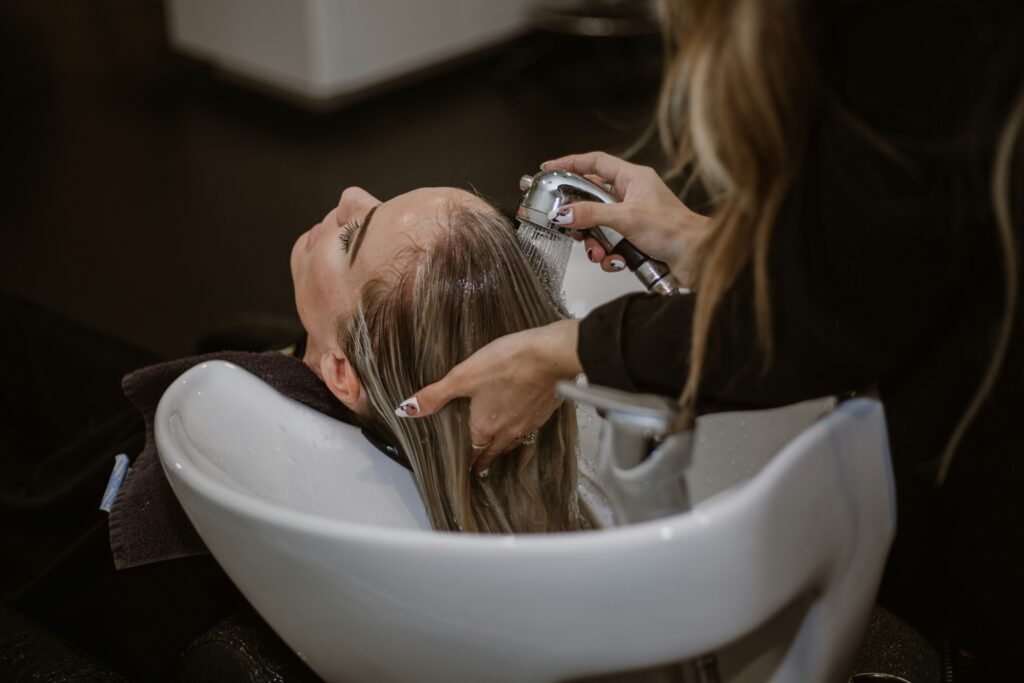The demand for hair treatments is on the rise, with many seeking smoother, shinier, and healthier locks. From keratin treatments and hair relaxers to scalp therapies and extensions, the choices are vast. However, chemicals in many treatments can lead to scalp irritation, hair damage, and even long-term health concerns.
Knowing the benefits and risks of popular hair treatments is crucial for making informed decisions about what’s safe and effective. In this article, we cover the rise of hair treatments, their associated risks, and what to consider before your next salon appointment.
Popular Hair Treatments and Their Risks
The rise in hair treatments, including keratin treatments, relaxers, coloring, and extensions, offers a range of options but comes with associated risks. Keratin treatments can cause scalp irritation and exposure to potentially harmful formaldehyde.
Hair relaxers may lead to hair breakage and scalp burns, and frequent use can exacerbate these issues. Coloring and highlighting use chemicals that may cause allergic reactions or irritation and can weaken hair, causing breakage.
Keratin Treatments
The FDA notes that hair-smoothing products with formalin or methylene glycol emit formaldehyde gas when heated, posing potential risks. OSHA enforces air quality standards, with exposure limits set at 0.1 ppm. Risks from these products can include skin and eye irritation, as well as respiratory problems. The FDA has warned companies about inadequate labeling and safety issues, advising consumers to exercise caution.
These treatments often contain formaldehyde or related chemicals, which can cause scalp irritation and respiratory issues. Prolonged exposure may weaken hair strands and lead to increased breakage.
To minimize risks, choose formaldehyde-free products and limit the frequency of treatments. Always follow product instructions carefully and consider consulting a dermatologist or stylist for advice on maintaining healthy hair.
Hair Relaxers
Strong chemicals in relaxers can cause hair damage, breakage, scalp burns, and, with frequent use, hair thinning or permanent loss. To reduce these risks, use milder formulations, avoid overuse, and follow manufacturer instructions closely.
Research cited by The New York Times links chemical hair relaxers to uterine cancer, reproductive health issues, and early menstruation. Studies such as the Sister Study revealed users were 2.5 times more likely to develop uterine cancer.
Professional application can help minimize adverse effects. Consulting a stylist about the best relaxer for your hair and proper post-treatment care can help protect against damage. Emerging research highlights concerns over hair straightener cancer, linking relaxers to increased risks of breast and uterine cancers.
TorHoerman Law highlights a surge in lawsuits as users accuse manufacturers of inadequate warnings about cancer risks. The International Agency for Research on Cancer (IARC) has labeled chemicals in hair relaxers, such as formaldehyde, as potential carcinogens. Consequently, legal filings against relaxer producers increased notably from 7,946 in August to 8,489 in September.
Scalp Treatments
Scalp treatments aim to address issues like dandruff, dryness, or oiliness, but they can also present risks. Certain treatments may cause allergic reactions or irritation, leading to discomfort and potential scalp damage.
Overuse of some products can disrupt the scalp’s natural balance, leading to sensitivity or worsening of existing conditions. To mitigate these risks, choose treatments suited to your specific scalp needs and perform a patch test before full application.
NCBI states hair product allergies from dyes and bleaching agents, like ammonium persulfate, are common among users and hairdressers. Studies show that 9% of contact dermatitis cases are due to hair products, with para-phenylenediamine (PPD) being the leading allergen. Alternatives like PTD and Me-PPD provide safer options, while proper diagnosis and prevention are essential.
Hair Coloring and Highlights
If these treatments are taken regularly, they may result in long-term harm, allergic responses, and scalp irritation. Chemical dyes have the potential to weaken hair, increasing its vulnerability to breakage and dryness. To minimize risks, opt for gentler, less harsh dyes and always conduct a patch test before full application.
Choosing products with fewer harsh chemicals and following proper application techniques can help protect your hair’s health. Regular conditioning and using protective products can also help maintain hair strength and minimize damage from coloring treatments.
Hair Extensions
Poorly applied extensions may lead to traction alopecia, where hair is pulled out from the scalp, or breakage due to tension. Extensions applied with glue or tape can cause scalp irritation or damage when removed.
Use high-quality extensions and make sure they are applied correctly by an expert to lower these dangers. When it comes to your natural hair, try not to tug or tense it too much. You should also think about giving it breaks between extension applications.
Regulations and Safety Standards
Hair treatment regulations vary by region, aiming to ensure the safety of products and protect consumer health. Regulations generally focus on limiting harmful chemicals and ensuring proper labeling.
It is essential to choose products that comply with local safety standards and have relevant certifications. Being aware of these regulations helps you select safer hair care products and avoid potentially hazardous treatments.
OSHA states that many smoothing treatments, such as Brazilian blowout, emit formaldehyde during use despite some claims to be “formaldehyde-free.” OSHA updated its hazard alert, mandating safety labels and SDS compliance. At the same time, formaldehyde’s cancer risks continue to undergo risk evaluation under the Toxic Substances Control Act (TSCA).
Choosing Safe Hair Treatments
Inquire about each product’s ingredients and possible hazards. Prior to complete administration, a patch test can help identify allergic reactions early. Prioritize treatments with fewer harsh chemicals and follow recommended usage guidelines.
Consider opting for products with safety certifications or those recommended by dermatologists. Regularly assess how your hair and scalp respond to treatments and adjust your routine as needed.
Frequently Asked Questions
What are the signs of an allergic reaction to hair treatment products?
Signs of an allergic reaction to hair treatment products include itching, burning, swelling of the scalp, face, or neck, and red rashes. Severe reactions may involve blisters, swollen eyelids, lips, or hands, and, in rare cases, anaphylaxis. Common allergens include paraphenylenediamine (PPD), ammonia, and peroxide.
Can frequent hair treatments lead to permanent hair damage or hair loss?
Yes, frequent hair treatments can lead to permanent damage or hair loss. The chemicals in treatments can weaken hair, causing breakage, thinning, and long-term damage. Overuse can also affect the scalp, leading to hair loss. Moderation and proper hair care are essential to minimize these risks and maintain healthy hair.
What should I ask a stylist before getting a new hair treatment to ensure it’s safe?
Ask your stylist about the treatment’s ingredients, potential side effects, and whether a patch test is recommended. Inquire about the treatment’s impact on your hair and scalp health and confirm that it meets safety standards. Understanding these aspects helps ensure the treatment is suitable for your hair type and minimizes potential risks.
Navigating Hair Treatments Safely
Keratin treatments, relaxers, coloring, and extensions can have side effects, including allergic reactions, hair damage, and potential long-term health concerns. To make informed decisions, understand these risks, and choose products with strong safety standards. Always consult with a stylist, perform patch tests, and consider less harmful alternatives to protect your hair health.



